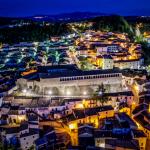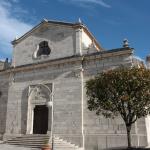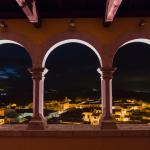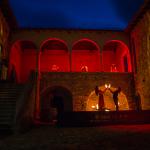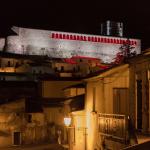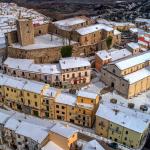The Municipality of Bisaccia is located in the Upper Irpinia area. It's a town with 3,799 inhabitants, located 860 metres above sea level, at 85 km from Avellino. The territory extends for 37.19 sq km and the adjoining municipalities are: Andretta, Aquilonia, Calitri, Guardia Lombardi, Lacedonia, Scampitella and Vallata.
The etymology of the name seems to come from the Latin Bi Saccus, which recalls the shoulder strap placed on the saddle of the pack animal. The inhabitants are called Bisaccesi and Saint Anthony of Padua is their patron saint.
PLACES OF INTEREST
- Church of the Natività di Maria (Nativity of Mary) (Co-Cathedral) - Built by the Normans with a Gothic style façade, it's the main place of worship in Bisaccia and it's not far from the Ducal Castle
- Ducal Castle of Bisaccia - Bastion which had the function of protecting the territories from enemy incursions, it then became a noble residence; from its loggia you can enjoy a beautiful view
- Civic Archaeologic Museum - It's set inside the castle and it preserves finds of the civilization of Oliveto-Cairano
- Capaldo Palace - Residence where the senator of the Kingdom of Italy Pietro Capaldo was born, located in the old part of Bisaccia
- Formicoso - A plateau with gentle steppe reliefs without trees, which was once the emperor's hunting ground
- Other - Church of S. Maria del Carmine (Our Lady of Mount Carmel), Church of Saint Gaetano, Church of S. Michele (Saint Michael), Chiesa dei Morti (Church of the Dead), Church of S. Antonio da Padua (Saint Anthony of Padua), Church of Contrada Oscata, Church of the Sacro Cuore (Sacred Heart)
EVENTS
- Feast of Saint Anthony of Padua - Feast of the town, in honour of the patron saint, with lights and concerts
- Estate bisaccese - Review of concerts and musical and cultural events, scheduled during the summer
- Feast of Saint Michael - A deeply felt religious celebration in the town, it's held in May and is inspired by the ancient country festivals
- Frederick II days- Parade of period costumes
- Processione del Calvario - Religious procession to Mount Calvary
- Saint Joseph fires - Traditional bonfires held on the 18th of March
TYPICAL FOOD AND PRODUCTS
- Cheek lard of Formicoso PAT - Triangular cut of pork, obtained from the cheek of the pig, with a component of high-quality fat
- Masciatica olive PAT - medium-sized fruit with medium-late ripening, sometimes used to make an oil with a fruity aroma and a sweet taste
- Caciocavallo di grotta PAT - Spun curd cheese, produced with milk from small and medium-sized farms, mainly from brown cattle, traditionally aged in caves
- Caciocavallo irpino di grotta PAT - Spun curd cheese, produced with milk from small and medium-sized farms, mainly from brown cattle, traditionally aged in caves
- Caciocavallo Silano PDO - Semi-hard cheese, with spun curd, produced with milk from different breeds of cows, including Podolica
FUN FACTS
Inside the castle there is a museum collection focused on the indigenous female world of the Oliveto-Cairano culture, unique in its genre. An unrepeatable journey through the traditional jewellery of women who lived in Eastern Irpinia between the 8th and 7th centuries.
Franco Arminio, Italian poet, writer and film director, self-described as a "village expert", is a native and resident of the village in Upper Irpinia.
HISTORICAL NOTES
Bisaccia has a very ancient history, rooted in the tradition of wool processing and cattle breeding. It was possible to prove the presence of a prehistoric social civilization dating back to 2300 BC from the numerous finds. Already in the 7th century BC, this civilization traded workers and wool products through the so-called “via della lana” (wool road) which connected the gulf of Manfredonia to that of Salerno.
The first mention of the medieval village dates back to 1087, in a document which speaks of Roberto, Lord of Bisaccia. This territory was crossed by the Roman, Lombard and Norman dominations until 1230, the year in which the fief passed to the Contigli family. Then, the latter was deprived of its throne by the Emperor Frederick II, who had the castle of Bisaccia, which was almost entirely destroyed by the earthquake of 1198, rebuilt, using the basement as a prison. The territory later experienced periods of Spanish, Austrian and Bourbon domination.
As for many other municipalities of Irpinia, also the history of Bisaccia has been marked by terrible earthquakes, among which those of 1456, 1694 (with the destruction of all the churches and more than two hundred houses), 1732 and 1980.
Bisaccia is ready to open its doors and unravel the mystery of its Princess to the "slow" travellers, those who are interested in enjoying its history and culture
Bisaccia
Corso Romuleo, 91, 83044 Bisaccia AV, Italia
Events
On Sunday 9th March the author Emanuela Sica will be present, as part of the event "Janare o…
-
A feast in honour of the patron saint of Bisaccia, a religious ritual that is a call to…
-
Concerts, shows and recreational attractions enliven the summer evenings in the town, with a…
-
It is a much-loved event in the town, held in May, and is based on ancient country festivals
On 14 September 2024 for the "Settembrini Festival" of the Borgo dell'Alta Irpinia, a concert…
-
Saturday 8th February the vernissage at the Ducal Castle. The works of Fabiana Gradisca from…
Featured places
Via Pietro Colletta, 83044 Bisaccia AV, Italia
A splendid bastion that served to protect the territory from enemy attacks, which later became…
Corso Romuleo, 171, 83044 Bisaccia AV, Italia
It was destroyed three times by earthquakes and today dominates the main square of Bisaccia,…
Via Pietro Colletta, 83044 Bisaccia AV, Italia
Located in the halls of the Ducal Castle of Bisaccia, it contains around 800 finds from the…
Did you like it? Leave a review
Your opinion is important! It will be visible after approval by the editorial staff.
To post a comment you must be an authenticated user. Log in with Social Login
